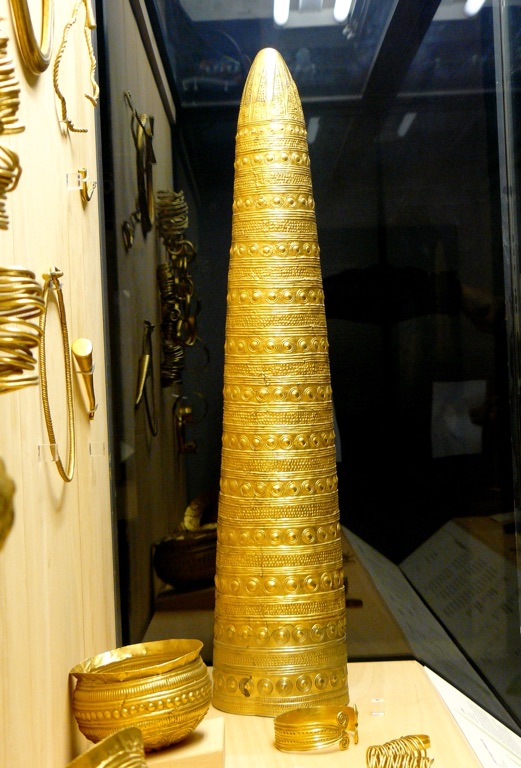The Avanton Gold Cone is a late Bronze Age artifact, remarkable for its craftsmanship and mystery. Discovered in Avanton, France, this cone is one of several known “Golden Hats” used in Central Europe during the Bronze Age. Made of thin gold leaf, it is intricately decorated with symbols whose meanings have been lost to time. The cone’s purpose and the identity of its makers remain subjects of speculation among historians and archaeologists.
Get your dose of History via Email
Historical Background of the Avanton Gold Cone
The Avanton Gold Cone surfaced in 1844 near the village of Avanton in France. It was found by chance, but details of the discovery are scant. The cone dates back to the Bronze Age, approximately 1000-900 BC. This period was marked by significant advancements in metalworking, as evidenced by the cone’s sophisticated design and construction.
Experts attribute the creation of the Avanton Gold Cone to the Urnfield culture, a prehistoric society that flourished in Central Europe. This culture is known for its funerary practices, including the use of urns for cremation. The cone’s discovery did not coincide with any known significant historical events or later habitation. Its original use remains a matter of conjecture.
There is no record of the Avanton Gold Cone being the scene of any historically important events. Its significance lies in its craftsmanship and the light it sheds on the cultural practices of the time. The cone is one of only a few such artifacts found across Europe, which suggests a shared cultural or religious significance among the disparate Bronze Age communities.
The Avanton Gold Cone has not been linked to any specific individuals or groups known from historical records. Its creators remain anonymous, known only through the legacy of their work. The artifact’s discovery did not immediately illuminate its purpose, leaving much to the imagination of those who study it.
Since its unearthing, the Avanton Gold Cone has been the subject of much scholarly interest. It resides in a collection where it continues to be examined for clues about its origin and purpose. The cone’s discovery has not led to any significant changes in the understanding of the period, but it remains an important piece of the Bronze Age puzzle.
About the Avanton Gold Cone
The Avanton Gold Cone is a masterful example of Bronze Age metalwork. Standing at about 55 centimeters tall, it is made from a sheet of gold, hammered into a thin leaf and shaped into a conical form. The craftsmanship indicates a high level of skill and an understanding of metal properties.
The cone’s surface is adorned with ornamental bands filled with symbols, including circles, dots, and lines. These decorations are not merely aesthetic; they may have held significant meaning for its creators. The precise method of the cone’s construction remains unknown, but it likely involved advanced techniques of the time.
Gold was a valuable and symbolic material in the Bronze Age, indicating the cone’s importance. The choice of material and the effort put into its creation suggest it was a significant object for its owners. The cone’s design and decoration are consistent with other similar artifacts found in Europe, hinting at a broader cultural connection.
Despite its age, the Avanton Gold Cone is in remarkable condition. This preservation allows for detailed study of its construction and design. The artifact provides a tangible connection to the past and the advanced metalworking skills of the Bronze Age.
The Avanton Gold Cone’s construction and materials highlight the sophistication of Bronze Age society. Its existence challenges modern perceptions of prehistoric peoples and their capabilities. The artifact is a testament to the ingenuity and artistry of its creators.
Theories and Interpretations
Several theories have emerged regarding the Avanton Gold Cone’s purpose. Some suggest it was a religious or ceremonial object, perhaps worn by a high-status individual during important rituals. The symbols may have had astrological or calendrical significance, used to track celestial events.
Another theory posits that the cone was part of a larger set of objects, possibly used in conjunction with other items for ritualistic purposes. The similarities between the Avanton Gold Cone and other Golden Hats found in Europe support this idea of a shared cultural or religious practice.
The mystery of the cone’s symbols has led to much speculation. Some researchers believe they may represent a form of prehistoric writing or symbolism. Matching these symbols to historical records has proven difficult, as no direct comparisons or explanations survive from that era.
Dating of the Avanton Gold Cone has been carried out using methods such as radiocarbon dating and analysis of the metal’s composition. These techniques have helped establish the cone’s age and the period in which it was created. However, the exact date of its manufacture remains approximate.
The Avanton Gold Cone continues to be a subject of study and interpretation. Its true purpose may never be fully understood, but it provides a valuable insight into the beliefs and practices of Bronze Age Europe. The artifact remains an enigmatic piece of history, inviting both scholarly research and public fascination.
At a glance
Country: France
Civilization: Urnfield culture
Age: Approximately 3000 years old (1000-900 BC)
Conclusion and Sources
Reputable sources used in the creation of this article include:

